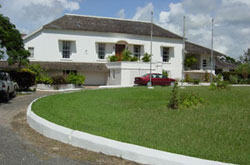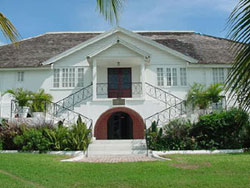
 Halse Hall Great House is a jewel
in Jamaican history restored by Alcoa minerals of Jamaica
Inc. Halse Hall stands in a region appropriately named
“Hato de Buena Vista” (ranch of the beautiful
view) by Spanish ranchers. Still remarkably impressive,
the view sweeps across verdant plains to the looming mist
shrouded Mocho Mountains.
Halse Hall Great House is a jewel
in Jamaican history restored by Alcoa minerals of Jamaica
Inc. Halse Hall stands in a region appropriately named
“Hato de Buena Vista” (ranch of the beautiful
view) by Spanish ranchers. Still remarkably impressive,
the view sweeps across verdant plains to the looming mist
shrouded Mocho Mountains.British soldier Thomas Halse settled here after fighting in the war that resulted in Spain's ceding Jamaica to the British in 1670. He raised hogs, grazed cattle and built a house of thick walls, containing living rooms and storerooms, surrounding a central square with squat bastions at each corner. It served as the centre of his estate and a rallying point for defence.
When Thomas Halse died in 1702, the great house was still a single story building. It became a more imposing and architecturally pleasing two- storied structure in an era of security and prosperity during the late 1740’s. Francis Sadler hals then owned the estate. A son of the second marriage of the widow of Thomas hals 2nd. An elaborate arrangement of stone steps ascends to the new entrance, which was flanked by columns and capped by with a fanlight. The peaked portico was added later to conform to a popular architectural style. Inside large mahogany doors gave entrance to the large living room and dining rooms, which were set off by mahogany wainscoting kitchen and servants quarters were at the rear.
 The
great house flourished and at the death of Francis Sadler
Halse in 1750, the estate passed to his wife Jannett. She
lived until 1775 when Halse Hall became the property of
her grandson, Thomas beach 2nd. He later
assumed the ancient family name of de La Beache and in
1801 his son Thomas Henry de La Beche, became owner of
Halse Hall plantation and the great house. Sir Henry
achieved renown as the leading English geologist of his
time. He lived at Halse Hall his ancestral home, while
studying the island geology and writing his important
paper “Remarks on the Geology of Jamaica”. Sir
Henry founded the geological survey of Great Britain
royal school of mines and the mining record office. He
also was president of the geological society of London
from 1847 to 1849. A plaque dedicated to the memory of
sir Henry Thomas de la beche was unveiled at Halse Hall
December 4, 1958, by governor of Jamaica sir Kenneth
Blackburn.
The
great house flourished and at the death of Francis Sadler
Halse in 1750, the estate passed to his wife Jannett. She
lived until 1775 when Halse Hall became the property of
her grandson, Thomas beach 2nd. He later
assumed the ancient family name of de La Beache and in
1801 his son Thomas Henry de La Beche, became owner of
Halse Hall plantation and the great house. Sir Henry
achieved renown as the leading English geologist of his
time. He lived at Halse Hall his ancestral home, while
studying the island geology and writing his important
paper “Remarks on the Geology of Jamaica”. Sir
Henry founded the geological survey of Great Britain
royal school of mines and the mining record office. He
also was president of the geological society of London
from 1847 to 1849. A plaque dedicated to the memory of
sir Henry Thomas de la beche was unveiled at Halse Hall
December 4, 1958, by governor of Jamaica sir Kenneth
Blackburn.
It is located above the arch on the west side of the great house. To settle debts, ownership of Halse Hall passed from the de La Beche family in the early 1850’s. A succession of owners down through the years has kept the great house in remarkably good state of preservation. It became the property of Alcoa minerals of Jamaica in 1969. Alcoa minerals have added a new wing that harmonises well with the great house architecture. It is used as living quarters for visitors to the bauxite mining and alumina refining operation. Plans call for a thorough restoration of the great house interior and refurbishing with historically accurate pieces.
The familiar plantation great houses have been described as gleaming jewels in the cultural heritage of Jamaica …visible links between past and present Jamaican history. The great house at Halse hall in the parish of Clarendon is regarded by historians as the oldest English building that still serves as a residence –a distinguished example of Jamaica’s fortress-plantation homes. Its present two storied form dates from the 1740’s and the basic structure was built in the latter half of the 1600’s. but parts of the great house foundation seem to have been laid for a Spanish ranch house well before then. In a small private cemetery a few yards from hales hall are the graves of some of the people who influenced the fascinating history of the estate. Major Thomas Halse, Thomas Halse 2nd, Thomas Halse 3rd, Jannett Sadler Halse, Thomas de La Beach and Helen de La Beach.